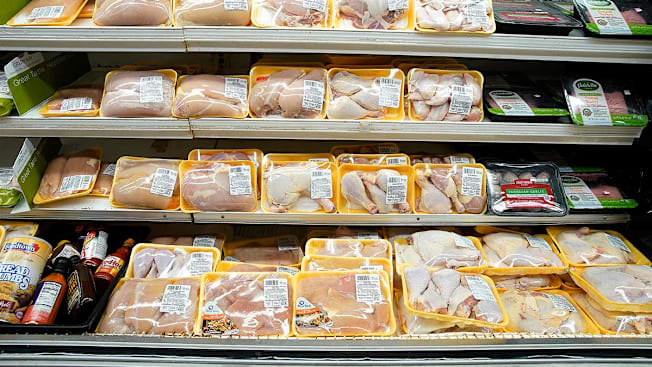
Food safety experts opposed the decision, citing concerns about infections from the dangerous bacteria
An estimated 200,000 annual illnesses from salmonella are the result of eating contaminated chicken.
By Lisa L. Gill
The Department of Agriculture’s Food Safety and Inspection Service announced this week that it is withdrawing a proposed rule that would classify certain raw poultry products contaminated with salmonella as “adulterated.” Such a designation would have, among other things, triggered the recall process or banned the product from being sold at retail.
The proposed rule was intended to help reduce the number of salmonella infections in the U.S. Of the estimated 1.35 million illnesses that occur each year from food tainted with the bacteria, nearly 200,000 of them are due to chicken, according to the Centers for Disease Control and Prevention. “And instead of declining, salmonella infections are increasing and expected to continue to grow,” says Brian Ronholm, director of food policy at Consumer Reports.
In its announcement, FSIS said that it received over 7,000 comments on the rule. “The agency believes that the comments have raised several important issues that warrant further consideration,” the announcement reads. FSIS also said that it withdrew the rule “to allow the Agency to further assess its approach for addressing Salmonella illnesses associated with poultry products.”
Currently, poultry producers are supposed to test chicken and turkey for salmonella and take action if levels exceed a certain threshold. But they are still allowed to sell the product while they investigate. And a recent CR analysis found that there are a large number of poultry plants in the U.S. with high levels of salmonella contamination.
The agency’s move has food safety advocates concerned that the government has weakened its ability to respond to foodborne illness outbreaks.
“This move, along with the steep budget and staffing cuts at the USDA and FDA, appears to be part of an overall effort to weaken food safety oversight,” says Brian Ronholm, director of food policy at Consumer Reports. “What it means for consumers is that ‘you’re on your own’ in figuring out how the food safety system is going to work for you. Ultimately, it’s an unfair burden.”
CR’s food safety experts have long called for the USDA to declare salmonella an adulterant in raw poultry, as the agency has done for deadly, toxin-producing strains of E. coli, such as E. coli O157:H7, in ground beef. Doing so proved to be a major boost to public health, and cut the number of E. coli cases linked to ground beef significantly, Ronholm says.
Sandy Eskin, CEO of Stop Foodborne Illness, a consumer advocacy organization, said, “It would not be surprising if there is at least one major foodborne illness outbreak linked to poultry in the next three or four years. And every outbreak corrodes consumer confidence in the food supply.” Eskin, former deputy undersecretary of food safety at FSIS, was involved in creating the proposed rule. “The government is supposed to ensure that industry is doing everything it can to make safe products,” she says. “But why are companies allowed to sell highly contaminated products?”
The National Chicken Council opposed the rule, saying at the time that it was “based on a mischaracterization of the presence of Salmonella in raw poultry, relies on misinterpretations of the science, and is legally unsound.” In a statement in response to the USDA withdrawing its rule, the council said it “appreciated” the announcement. “We remain committed to further reducing salmonella and fully support food safety regulations and policies that are based on sound science, robust data, and are demonstrated to meaningfully impact public health,” the statement said.
The Risks of Salmonella
Salmonella contamination is widespread in poultry because of the often crowded and filthy conditions in which they are raised, says CR’s Ronholm.
Worryingly, a 2022 CR investigation, for example, found nearly one-third of ground chicken samples tested contained salmonella. Of those, 91 percent were contaminated with one of the three strains that pose the biggest threat to human health: infantis, typhimurium, and enteritidis.
How to Stay Safe From Salmonella
Now, more than ever, it’s important to take steps in your kitchen to stay safe and reduce your risk of salmonella. These include:
Keep food separated while shopping at the grocery store. Keep raw meats in a disposable bag, away from other foods, especially ones you’re likely to eat raw—like fruit and salad.
Store raw meat in a bag or bowl in the refrigerator. This will catch any juices that might leak from the packaging and contaminate your fridge.
Thaw frozen meat in the refrigerator. This will impede the growth of bacteria.
Don’t rinse raw meat. Doing so can spread bacteria around your sink or counter.
Wash your hands in hot, soapy water before prepping, after you touch raw meat, and again when you’re finished. Wash knives used on meat before using them to cut other foods.
Use a separate cutting board for meat. Keep another one specifically for vegetables and other nonmeat foods.
Cook poultry to an internal temperature of 165° F. Use a meat thermometer to check. It’s the only sure way to make sure you’ve cooked chicken and turkey to the temperature you need to kill salmonella.
Consumer Reports is an independent, nonprofit organization that works side by side with consumers to create a fairer, safer, and healthier world. CR does not endorse products or services, and does not accept advertising. Copyright © 2025, Consumer Reports, Inc.